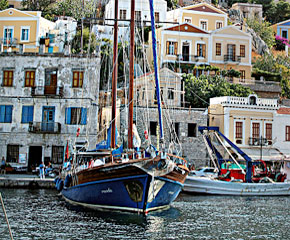I’m standing in my kitchen rolling dolmades. My sea legs make it feel like the floor is rocking, and pinned on my fridge is an e-mail from Athens-born chef Theodore Kyriakou.
‘…Being at sea is so beautiful,’ it reads, ‘there is no dashing to the corner shop for some lemongrass or milk!’
You remove your shoes before you come on board and as you drop your minimalist luggage in your cabin.
The real Greek
It takes me right back to the Grandi, Tussock Cruising’s 25-metre, seven-cabin gullet, where I first met Theodore on a weeklong culinary cruise.
He has written a number of cookbooks and launched many a
successful London restaurants, I joined nine cooks to learn his authentic Greek recipes.
Sights, sounds and tastes
Besides a bit of light cooking, all that was required of us was to recline on bright blue sun loungers.
In between familiarising ourselves with Greek ingredients and cooking techniques, we got to know the islands beyond the perspective from the boat.
One night in Thilos, Theodore sat quietly in an ouzeri, observing the locals with a smile. I joined him on one of the lowslung, sun-faded chairs and he began to tell me about Greece and his mother’s cooking.
He described a way of life that is pure simplicity, one that doesn’t know shortcuts or substitutes. Lunch might have been a cup of chilled yoghurt and chickpea soup as you came off the beach.
Theodore recalled the taste of sea urchins freshly and he asked how South Africans prepare perlemoen, and when I mentioned olliekriek he became animated again, shaking his head and laughing: ‘What! An oily Greek?’
Greek feasting
‘Come, let’s go and see the kitchen,’ beckoned Theodore as we headed for the cramped take-away area. Two weary looking
ladies were leaning on the counter, their bottle-blonde hair scooped into netting-backed sailor caps. As Theodore
started speaking in Greek, their interest was piqued.
After much conversation back and forth Theodore seemed satisfied. What translated as ‘pies’ on the menu turned out to be slices of piquant cured meat, like a thick-sliced wet bresaola, topped with tomato and
a grated local cheese – pastrouma saganaki.
We tried a ‘spoon-sweet’ of miniature firiki apple from Mount Pelion which had the texture and sweet intensity of watermelon konfyt. These are seldom eaten as dessert, but rather, on waking from a siesta.
We finished with a golden dessert wine called karidopita that had an aftertaste of plum, and experienced the difference between cheap, throat-searing ouzo and premium aromatic ouzo from Chios.
We learned how beautiful Greek wine can be with a bottle of Villare by Emery on the island of Rhodes. And that retsina isn’t the only obvious food and wine pairing.
Edible cruising
Even on the boat Theodore treated our palates like slates to be wiped clean.
‘I want to show you something,’ he said opening his suitcase. Our enlightenment started with ewe’s milk yoghurt that was more akin to crème fraîche – sharp, creamy and thick. The bland, grainy, cow’s milk equivalent didn’t come close.
His pale-beige taramasalata was more like a handmade mayonnaise which, can be eaten by the teaspoon only, not by the tub.
On the final day we needed to make up time. ‘You must roll them tightly to be perfectly bitesized,’ repeated Theodore as we rolled dolmades side by side.
‘And you cannot stick to yourself. The person you are rolling with wants to know about your love life, who you were with last night and what your therapist thinks.’
I laugh as I remember Theodore’s words, now rolling my vine leaves with ease after having learned on a moving yacht. All that’s missing is the sun-scorched backdrop and
a crew member to top up my rosé.
Image:A Tussock gulet moored in Symi.

